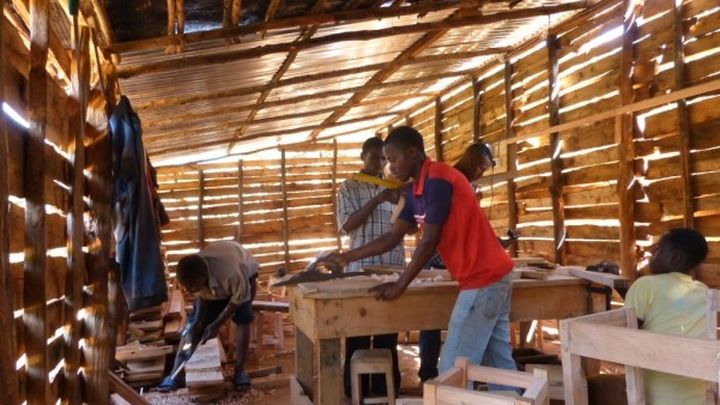
LSM Vocational Training Center
Donation protected
Project Summary
Within Tanzania, opportunity beyond primary education is not a right, but a luxury. Countless youth, especially within rural villages, are incapable of continuing onto secondary education due to the financial burden, regardless of their previous and potential academic success. This problem has left a substantial portion of the Tanzanian populous under qualified to find work beyond subsistence farming, resulting in extreme poverty. Without any opportunities of stable income and education, many resort to prostitution and drug abuse and many are left without the knowledge to care for and maintain their own health and wellbeing.
At present, there is a small carpentry school within the affected community that caters to youth without the financial means to continue onto higher education. The school has been running for years and has proven successful. Instead of paying tuition, the students’ educations are funded by the work they produce, and has provided enough income to maintain both tools and the workshop. Over the years, the school has assisted many students improve their quality of life by allowing them achieve gainful employment within the community, neighboring communities, and in other major Tanzanian cities. However, due to a lack of resources and money, the school is only capable of teaching about four students at a time, all of which are male. By increasing the size of the school through construction of a new building, the community aims to increase the capacity of the carpentry school, but also to add space for programs that teach at-risk youth masonry, tailoring, and HIV prevention. Our objective is to not only make the school more profitable and sustainable, but to improve the quality of life for more community members of both genders.
It is expected that the completion of this project will allow approximately 130 at-risk students within five years to increase their health and standard of living through HIV prevention and the learning of an occupational trade. Newly acquired knowledge of relevant health issues and the students’ trade will be evaluated by written examinations, while practical examinations will be given to assess newly acquired skills. Women will also be given more opportunity through the school through quota mandates and the inclusion of additional trades. Lastly, the school will serve as an example of an affordable alternative means of education in Tanzania.
Our aim is to complete construction and open the school by February 2015. The total project cost is around 28 million shillings, while 31% will be funded by the community. A committee consisting of the schools’ teachers and several other community members will manage project funds and ensure project completion.
Background
The community of focus is located in a small village in the Usambara Mountains, adjacent to a government-protected rainforest. The village is home to nearly 7,500 villagers, nearly all of which are subsistence farmers. As a result of the neighboring rainforest, high altitude, and abundant precipitation create an environment that allows villagers to grow a wide variety of crops ranging from maize, cabbage, and bananas to peaches, raspberries, and coffee. The diversity of plant species and varying topography has also given rise to a rich tourism industry, making the village home to several popular hotels. However, even with the array of resources and abundance of tourism, the community faces many economic challenges.
Currently, the Usambara Mountain region has one of the highest population growth rates in Tanzania. This population growth has resulted in extreme poverty, reducing opportunities for quality education among the region’s youth. In a community where education beyond the seventh grade is unaffordable to many, a large portion of the population is left without the skills and knowledge necessary for employment or opportunity beyond subsistence farming.
In order to provide an alternative for youth without the financial means to continue to secondary or A level education, members of the village have founded a carpentry school that allows students to fund their education through the sale of the work that they produce while attending. A certified carpentry teacher with over twenty years experience, who has received formal education in both teaching methods and business, operates the school. The school's curriculum is three years with practical exams given every three months. Within the last year, the school’s founder has also assisted a local mason in the establishment of masonry training school to provide an additional vocational training option to at-risk youth, free tuition.
Presently, the carpentry school has only four students due to limited space, and possesses a very limited number and assortment of tools, which reduces efficiency and the variety of techniques that may be learned. The masonry school has five students, but no classroom for theoretical coursework. All of the students currently attending each of these programs are male. Despite these shortcomings, the school’s founders and the community at large take much pride in the workshop and would like the opportunity to expand the school’s capacity to accommodate additional students in the carpentry and masonry programs, while also expanding its offerings to include tailoring. There is hope that with continued growth, these programs will serve as an exemplary model for alternative education in the region.
Community Involvement
In an area where education beyond the seventh grade is beyond the financial means of the majority, where the main source of family income is subsistence farming, and where teenage pregnancy, alcoholism, and HIV/AIDS are persistent and common problems, members of the community have already recongnized the need to provide alternative, affordable forms of education. The carpentry school’s founder has been teaching students from within the village for several years, many of whom have since found work in neighboring villages within the lushoto region , as well as in major cities such as Dar es Salaam and Arusha. Unfortunately, the school can only accommodate four students at a time. These few available spots remain full for the duration of the three-year program, despite an abundance of at-risk youth who wish to participate and learn a valued trade.
The community wishes to allow additional students to pursue education in carpentry and masonry, but it would also like to provide education opportunities to financially burdened young women as well. The founder of the carpentry school has begun working with two female tailors in the community to develop a tuition free training program in the tailoring that will follow the model established by the programs in carpentry and masonry, allowing female students to fund their education through the sale of the work they produce.
The community will be contributing 32% of the total funding required for completion of the project. This will include building materials and labor, with the carpentry and masonry schools working together to construct the new building.
Outcome
The desired outcome of the project is to provide more at risk youth the opportunity to continue their education for free, qualifying them for gainful employment, and ultimately improving their standard of living. By increasing the space in the carpentry workshop, the school will be capable of graduating ten students per year, as opposed to the current number of five every three years.
The construction of the school will serve as a practical learning opportunity for the students of the masonry school. To construct the building, the school will be using an environmentally appropriate technology recently acquired by the community: a block press that uses soil and cement without requiring the burning of trees from the local rainforest to fire-treat the bricks. After the completion of the project, the masonry school will have experience with a new technology, as well as a classroom that will serve as a venue to study theoretical coursework.
By adding a space for a tailoring program, the school will be able to serve both genders, creating a more gender equitable model for alternative education in the community.
Through higher education and providing youth with a constructive use of time and a sense of purpose, and the potential for greater financial stability, the community hopes to reduce the rate of teenage pregnancies, HIV transmission, and the occurance of substance abuse, while improving the wellbeing of generations to come.
Implementation
The project will be implemented in four phases:
Phase 1 – Site evaluation and Planning: The first phase includes the establishment of the location for construction of the new school building and the production of construction drawings (see pages 14-19).
Phase 2 – Purchase and Transport of Building Materials: All materials will be purchased locally within the village, with the exception of roofing, which will be purchased in nearby Lushoto town.
Phase 3 – Construction: All construction labor will be completed in a joint effort performed by the teachers and students of the masonry and carpentry programs, working together with the assistance of several other experienced volunteers from the community.
Phase 4 – Monitoring and Evaluation: Building condition and student performance will be tracked and evaluated. All building maintenance will be performed by teachers and students enrolled in the carpentry and masonry programs, and all money to fund material costs will come from the profit made by all three departments: masonry, carpentry, and tailoring. Student progress across all three disciplines will be tracked and evaluated by quarterly written and practical examinations.
Capacity Building:
Increasing the space within the carpentry school, will allow more students to enroll and contribute to the work the school produces. The wider range of projects that the school is able to complete, will enable the school to generate more income as well as provide services to the community that were previously not available.
By providing space and equipment for a tailoring school, female at-risk youths from the community will also have the opportunity to further their education without the prohibitive expenses that some other programs currently offer. Graduates of the school will serve as role models within the community for younger girls, demonstrating that women have the capacity to continue their educational pursuits, gain employment, and support themselves as well as their families financially.
The use of an environmentally appropriate technology in constructing the school, will allow masonry students to learn an alternative method of building that protects the nearby rainforest. For the community, the building will serve as an example of an available means of preserving the local environment, and may increase the demand for the masonry school’s assistance in future building projects.
The project will also provide free education to students of all socioeconomic classes, teaching students who are otherwise financially incapable of continuing to secondary or A level education the skills that qualify them for gainful employment. This project will allow anyone within the community the opportunity to improve their standard of living.
Sustainability
In establishing the carpentry school, the founder had received a donation of five hundred euros. Since the opening of the school the founder has added on to the space, increased the number of tools, as well as the number of students. By building furniture for clients around the Usambara Mountains with the help of his students, the founder has been able to not only provide affordable education for his students but also generate enough income to reinvest in and improve the quality of the school. Through this project, the school will have more machines and more students to service a higher number of clients in order to generate more income, allowing the school to continue expanding and improving in the future.
The included tailoring school will follow the format of the carpentry school and will also take orders from the surrounding community, permitting students to fund their own education with the work they themselves produce.
Monitoring & Evaluation
All students will increase their capacity within their desired trade, as well as improve their capacity to maintain and improve their sexual health. The school has already introduced a sexual health lesson into their curriculum that each student must attend and demonstrate full competency. The students learn what HIV is, how it is transmitted, and how it is prevented. Students are also given a demonstration on proper condom use, as well as information on what local contraceptive methods are available. All sexually active students are encouraged to test for HIV two to four times per year.
Budget Narrative
All funds will be used for the purchasing and transportation of building material. Price estimations were obtained by the head of the masonry school who has prior knowledge of building material costs and who is also in charge of the construction of the new school building. Assets that will be contributed by the community include readily available natural resources, such as lumber, stone, and physical labor. All bricks will be made and contributed by the masonry school.
Do No Harm Discussion
The study of carpentry uses a lot of wood, especially for beginner students who’s work will not be suitable for sale and will serve exclusively as a platform ofr practicing various techniques. With the expansion of the school and increased enrollment, the amount of lumber required will surely increase, creating the potential for the further deforestation in the surrounding area.
Making certain that all lumber comes from local tree farms and not the nearby rainforest will mitigate the school’s environmental impact. The school will also be built using bricks made from a mixture of pressed soil, cement, and water as opposed to the locally made fire treated bricks. This will drastically reduce the number of felled trees in the construction of the school, as well as serve as an example of an environmentally responsible means of construction.
Goals & Objectives
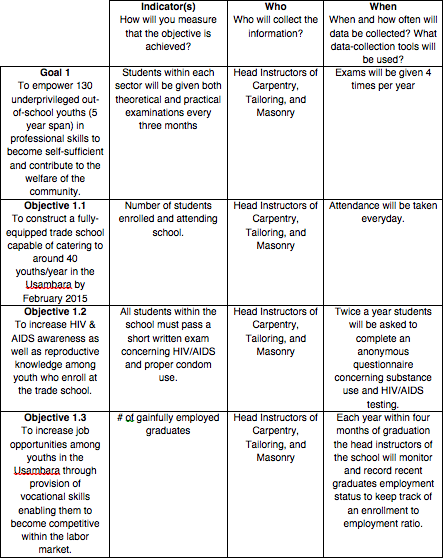
Timeline:
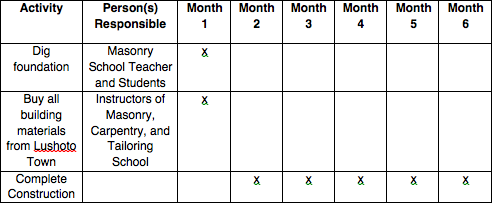
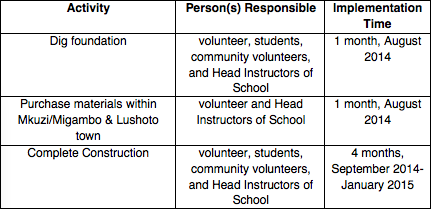
Site of Construction:
The construction of the new building for the trade school will replace the currently functioning carpentry workshop. During the construction of the new building, the school will continue to function as the walls of the new workshop are erected surrounding the former carpentry workshop.
The structure beside the site of the workshop is the home of the carpentry instructor. The new trade school will be built adjacent to the instructors home and will be built with a second floor.
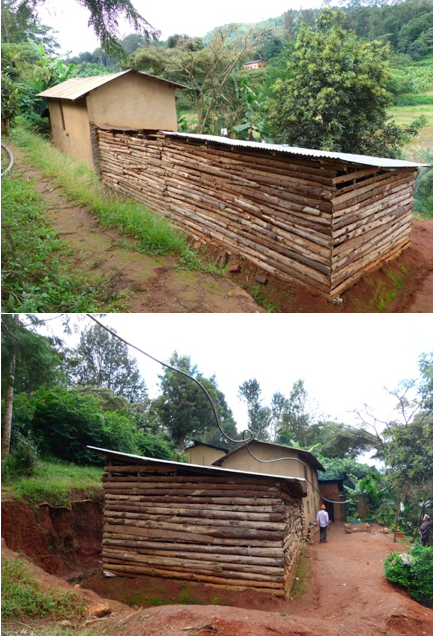
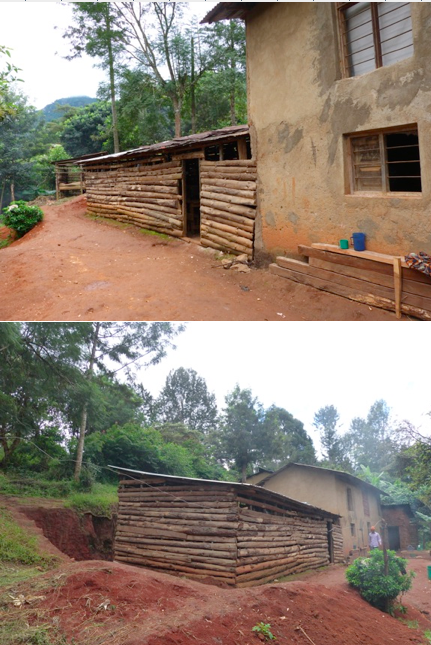
Budget:
 Asking Amount in USD= 11,339.00
Asking Amount in USD= 11,339.00Blueprints:
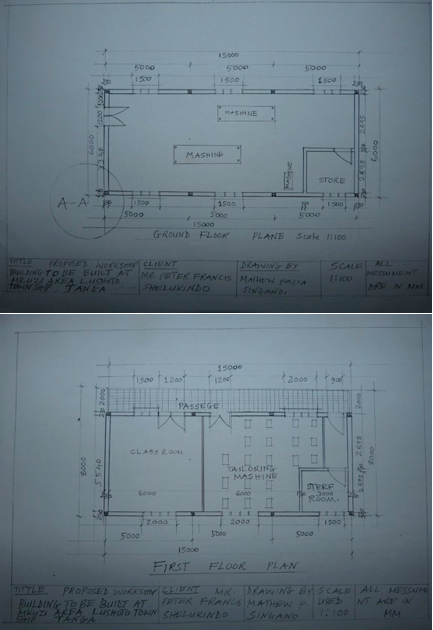
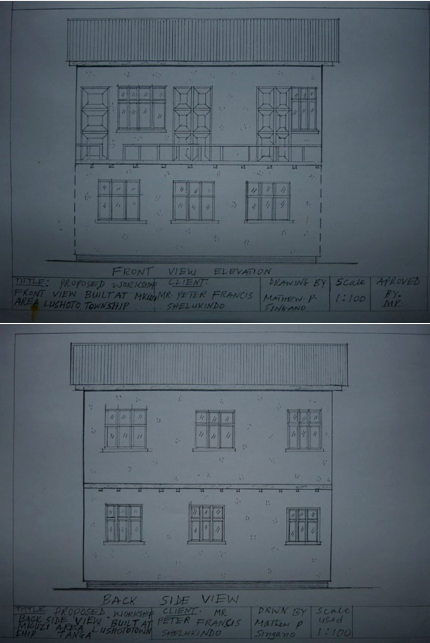
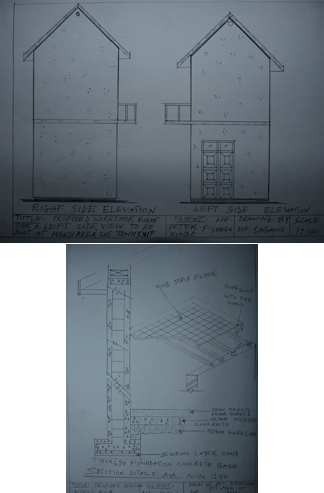
Material Purchasing & Transport Plan:
All materials with the exception of roofing will be purchased within the village, thereby supporting local business and reducing transportation costs. Raw materials such as sand and stone will be collected locally, while the surrounding community will contribute lumber and additional stone. All lumber will come from several neighboring tree farms and will be cut and prepared by the carpentry school.
Security Plan:
Because the site of construction is at the home of the carpentry instructor, materials will be safely stored in the instructor’s first floor storage room.
Maintenance Plan:
After completing construction of the new school, all future maintenance will be performed by both the masonry and carpentry school’s teachers and students working together. Because the students and instructors are the beneficiaries of all school maintenance, labor will be free. Income received from each training sector will contribute towards maintenance material costs.
Organizer
Jake Donaghy
Organizer
Begin your fundraising journey


